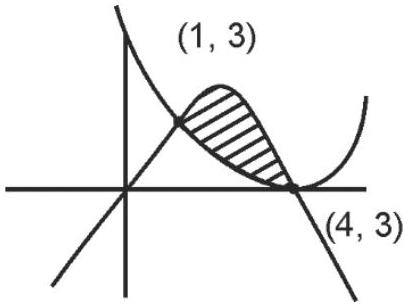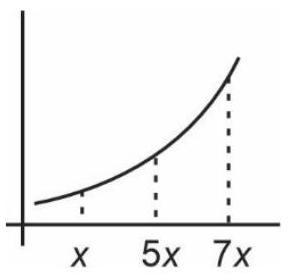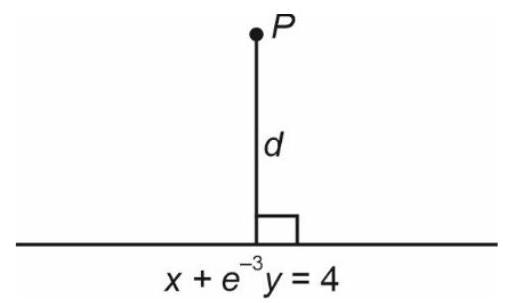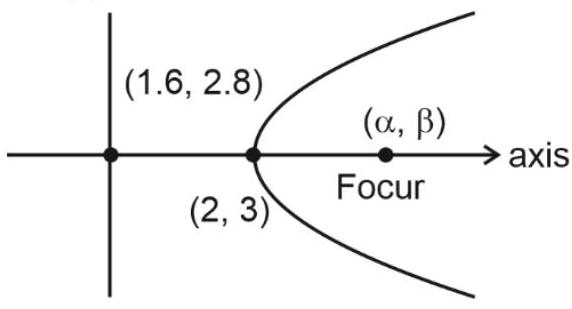Jee Main 2024 31 01 2024 Shift2
Question 1
$a=\sin ^{-1}(\sin 5), b=\cos ^{-1}(\cos 5)$ then $a^{2}+b^{2}$ is equal to
(1) $8 \pi^{2}-40 \pi+50$
(2) $4 \pi^{2}+25$
(3) $8 \pi^{2}-50$
(4) $8 \pi^{2}+40 \pi+50$
Show Answer
Answer: (1)
Solution:
$a=\sin ^{-1}(\sin 5)=5-2 \pi$
and $b=\cos ^{-1}(\cos 5)=2 \pi-5$
$\therefore a^{2}+b^{2}=(5-2 \pi)^{2}+(2 \pi-5)^{2}$
$=8 \pi^{2}-40 \pi+50$
Question 2
A coin is biased such that head has two chances than tails, what is the probability of getting 2 heads and 1 tail?
(1) $\frac{1}{29}$
(2) $\frac{2}{29}$
(3) $\frac{1}{9}$
(4) $\frac{4}{9}$
Show Answer
Answer: (4)
Solution:
Let probability of tail is $\frac{1}{3}$
$\Rightarrow$ Probability of getting head $=\frac{2}{3}$
$\therefore \quad$ Probability of getting 2 heads and 1 tail
$$ \begin{aligned} & =\left(\frac{2}{3} \times \frac{2}{3} \times \frac{1}{3}\right) \times 3 \\ & =\frac{4}{27} \times 3 \\ & =\frac{4}{9} \end{aligned} $$
Question 3
Let mean and variance of 6 observations $a, b, 68$, $44,40,60$ be 55 and 194 . If $a>b$ then find $a+3 b$
(1) 211.83
(2) 201.59
(3) 189.57
(4) 198.87
Show Answer
Answer: (2)
Solution:
$\frac{a+b+68+44+40+60}{6}=55$
$212+a+b=330$
$\Rightarrow a+b=118$
$\frac{\sum x _i^{2}}{n}-(\bar{x})^{2}=194$
$\frac{a^{2}+b^{2}+(68)^{2}+(44)^{2}+(40)^{2}+(60)^{2}}{6}-(55)^{2}=194$
$=3219$
$11760+a^{2}+b^{2}=19314$
$\Rightarrow a^{2}+b^{2}=19314-11760$
$=7554$
$(a+b)^{2}-2 a b=7554$
From here $b=41.795$
$a+b=118$
$\Rightarrow a+b+2 b=118+83.59$
$=201.59$
Question 4
If $2^{\text {nd }}, 8^{\text {th }}, 44^{\text {th }}$ terms of A.P. are $1^{\text {st }}, 2^{\text {nd }}$ and $3^{\text {rd }}$ terms respectively of G.P. and first term of A.P. is 1 then the sum of first 20 terms of A.P. is
(1) 970
(2) 916
(3) 980
(4) 990
Show Answer
Answer: (1)
Solution:
$a+d, a+7 d$ and $a+43 d$ are $1^{\text {st }}, 2^{\text {nd }}, 3^{\text {rd }}$ term of G.P.
$\frac{a+7 d}{a+d}=\frac{a+43 d}{a+7 d}$
$\Rightarrow(a+7 d)^{2}=(a+d)(a+43 d)$
$\Rightarrow a^{2}+49 d^{2}+14 d=a^{2}+44 a d+43 d^{3}$
$\Rightarrow 6 d^{2}=30 a d$
$\Rightarrow d^{2}=5 d$
$\Rightarrow d=0,5$
$a=1, d=5$
$S _{20}=\frac{20}{2}[2+(19) 5]$
$=10[95+2]$
$=970$
Question 5
The area of the region enclosed by the parabolas $y=4-x^{2}$ and $3 y=(x-4)^{2}$ is in (sq. unit)?
(1) $\frac{14}{3}$
(2) 4
(3) $\frac{32}{3}$
(4) 6
Show Answer
Answer: (4)

Solution:
Area $=\left|\int _1^{4}\left[(4-x)^{2}-\frac{(x-4)^{2}}{3}\right]\right| d x$
Area $=\left|4 x-\frac{x^{3}}{3}-\frac{(x-4)^{3}}{9}\right| _1^{4}$
$=\left|\left(16-\frac{64}{3}\right)-\left(4-\frac{1}{3}+\frac{27}{9}\right)\right|$
$=\left|16-\frac{64}{3}-4+\frac{1}{3}+3\right|$
$=|15-2|=6$
Question 6
If $A\left[\begin{array}{l}1 \\ 0 \\ 1\end{array}\right]=2\left[\begin{array}{l}1 \\ 0 \\ 1\end{array}\right], A\left[\begin{array}{c}-1 \\ 0 \\ 1\end{array}\right]=4\left[\begin{array}{c}-1 \\ 0 \\ 1\end{array}\right]$
and $A\left[\begin{array}{l}0 \\ 1 \\ 0\end{array}\right]=2\left[\begin{array}{l}0 \\ 1 \\ 0\end{array}\right]$ where, $A$ is a $3 \times 3$ matrix and $(A-3 /)\left[\begin{array}{l}x \\ y \\ z\end{array}\right]=\left[\begin{array}{c}-1 \\ 2 \\ 3\end{array}\right]$ then the value of $(x, y, z)$ is
(1) $(1,2,3)$
(2) $(1,-2,3)$
(3) $(1,-2,-3)$
(4) $(-1,-2,-3)$
Show Answer
Answer: (3)
Solution:
Let $A=\left[\begin{array}{lll}x _1 & y _1 & z _1 \\ x _2 & y _2 & z _2 \\ x _3 & y _3 & z _3\end{array}\right]$
$$ \text { Given } A=\left[\begin{array}{l} 1 \tag{1}\ 0 \\ 1 \end{array}\right]=\left[\begin{array}{l} 2 \\ 0 \\ 2 \end{array}\right] $$
$$ \begin{aligned} & \therefore\left[\begin{array}{l} x _1+z _1 \\ x _2+z _2 \\ x _3+z _3 \end{array}\right]=\left[\begin{array}{l} 2 \\ 0 \\ 2 \end{array}\right] \\ & \therefore x _1+z _1=2 \ldots \text{(2)}\\ & \quad x _2+z _2=0 \ldots \text{(3)}\\ & x _3+z _3=0 \ldots \text{(4)} \end{aligned} $$
Given $A=\left[\begin{array}{c}-1 \\ 0 \\ 1\end{array}\right]=\left[\begin{array}{c}-4 \\ 0 \\ 4\end{array}\right]$
$\therefore\left[\begin{array}{l}-x _1+z _1 \\ -x _2+z _2 \\ -x _3+z _3\end{array}\right]=\left[\begin{array}{l}4 \\ 0 \\ 4\end{array}\right]$
$\Rightarrow-x _1+z _1=-4$
$-x _2+z _2=0$
$$ \begin{equation*} -x _3+z _3=4 \tag{6} \end{equation*} $$
Given $A=\left[\begin{array}{l}0 \\ 1 \\ 0\end{array}\right]=\left[\begin{array}{l}0 \\ 2 \\ 0\end{array}\right]$
$$ \therefore\left[\begin{array}{l} y _1 \\ y _2 \\ y _3 \end{array}\right]=\left[\begin{array}{l} 0 \\ 2 \\ 0 \end{array}\right] $$
$\therefore y _1=0, y _2=2, y _3=0$
$\therefore$ from (2), (3), (4), (5), (6) and (7)
$x _1=3, x _2=0, x _3=-1$
$y _1=0, y _2=2, y _3=0$
$z _1=-1, z _2=0, z _3=3$
$\therefore A=\left[\begin{array}{ccc}3 & 0 & -1 \\ 0 & 2 & 0 \\ -1 & 0 & 3\end{array}\right]$
$\therefore$ Now $(A-3 I)\left[\begin{array}{l}x \\ y \\ z\end{array}\right]=\left[\begin{array}{c}-1 \\ 2 \\ 3\end{array}\right]$
$\therefore\left[\begin{array}{rrr}0 & 0 & -1 \\ 0 & -1 & 0 \\ -1 & 0 & 0\end{array}\right]\left[\begin{array}{l}x \\ y \\ z\end{array}\right]=\left[\begin{array}{r}-1 \\ 2 \\ 3\end{array}\right]$
$\left[\begin{array}{l}-z \\ -y \\ -x\end{array}\right]=\left[\begin{array}{r}-1 \\ 2 \\ 3\end{array}\right]$
$[z=1],[y=-2],[x=-3]$
Question 7
Let $f: R \rightarrow(0, \infty)$ be increasing function such that $\lim _{x \rightarrow \infty} \frac{f(7 x)}{f(x)}=1$ then $\lim _{x \rightarrow \infty}\left(\frac {f(5 x)}{f(x)}-1\right)$ is equal to
(1) Zero
(2) 4
(3) 1
(4) $\frac{4}{5}$
Show Answer
Answer: (1)
Solution:
$f$ is increasing function
$x<5 x<7 x$

$f(x)<f(5 x)<f(7 x)$
$\frac{f(x)}{f(x)}<\frac{f(5 x)}{f(x)}<\frac{f(7 x)}{f(x)}$
$\lim _{x \rightarrow \infty} \frac{f(x)}{f(x)}<\lim _{x \rightarrow \infty} \frac{f(5 x)}{f(x)}<\lim _{x \rightarrow \infty} \frac{f(7 x)}{f(x)}$
$1<\lim _{x \rightarrow \infty} \frac{f(5 x)}{f(x)}<1 \Rightarrow \lim _{x \rightarrow \infty} \frac{f(5 x)}{f(x)}=1$
$\lim _{x \rightarrow \infty}\left(\frac{f(5 x)}{f(x)}-1\right)=0$
Question 8
Let $z _1$ and $z _2$ be two complex numbers such that $z _1+z _2=5$ and $z _1^{3}+z _2^{3}=20+15 i$, then the value of $\left|z _1^{4}+z _2^{4}\right|$ is equal to
(1) 75
(2) $25 \sqrt{5}$
(3) $15 \sqrt{15}$
(4) $30 \sqrt{3}$
Show Answer
Answer: (1)
Solution:
$z _1+z _2=5$
$$ \begin{aligned} & z _1^{3}+z _2^{3}=20+15 i \\ & z _1^{3}+z _2^{3}=\left(z _1+z _2\right)^{3}-3 z _1 z _2\left(z _1+z _2\right) \\ & z _1^{3}+z _2^{3}=125-3 z _1 \cdot z _2(5) \\ & \Rightarrow 20+15 i=125-15 z _1 z _2 \\ & \Rightarrow 3 z _1 z _2=25-4-3 i \\ & 3 z _1 z _2=21-3 i \\ & z _1 \cdot z _2=7-i \\ & \left(z _1+z _2\right)^{2}=25 \\ & z _1^{2}+z _2^{2}=25-2(7-i) \\ & =11+2 i \\ & \left(z _1^{2}+z _2^{2}\right)^{2}=121-4+44 i \end{aligned} $$
$$ \begin{aligned} & \Rightarrow \quad z _1^{4}+z _2^{4}+2(7-i)^{2}=117+44 i \\ & \Rightarrow \quad z _1^{4}+z _2^{4}=117+44 i-2(49-1-14 i) \\ & =21+72 i \\ & \Rightarrow \quad\left|z _1^{4}+z _2^{4}\right|=75 \end{aligned} $$
Question 9
The number of solutions of equation $e^{\sin x}-2 e^{-\sin x}=2$ is
(1) More than 2
(2) 2
(3) 1
(4) 0
Show Answer
Answer: (4)
Solution:
Take $e^{\sin x}=t(t>0)$
$\Rightarrow t-\frac{2}{t}=2$
$\Rightarrow \frac{t^{2}-2}{t}=2$
$\Rightarrow t^{2}-2 t-2=0$
$\Rightarrow t^{2}-2 t+1=3$
$\Rightarrow(t-1)^{2}=3$
$\Rightarrow t=1 \pm \sqrt{3}$
$\Rightarrow t=1 \pm 1.73$
$\Rightarrow t=2.73$ or -0.73 (rejected as $t>0$ )
$\Rightarrow e^{\sin x}=2.73$
$\Rightarrow \log _e e^{\sin x}=\log _e 2.73$
$\Rightarrow \sin x=\log _e 2.73>1$
So no solution.
Question 10
The line passes through the centre of circle $x^{2}+y^{2}-16 x-4 y=0$, it interacts with the positive coordinate axis at $A \& B$. Then find the minimum value of $O A+O B$, where $O$ is origin.
(1) 20
(2) 18
(3) 12
(4) 24
Show Answer
Answer: (1)
Solution:
$(y-2)=m(x-8)$
$$ \begin{aligned} & \Rightarrow \quad x \text {-intercept } \\ & \Rightarrow \quad\left(\frac{-2}{m}+8\right) \\ & \Rightarrow y \text {-intercept } \\ & \Rightarrow(-8 m+2) \\ & \Rightarrow O A+O B=\frac{-2}{m^{2}}+8-8 m+2 \\ & f^{\prime}(m)=\frac{2}{m^{2}}-8=0 \\ & \Rightarrow m^{2}=\frac{1}{4} \end{aligned} $$
$$ \begin{aligned} & \Rightarrow m=\frac{-1}{2} \\ & \Rightarrow \quad f\left(\frac{-1}{2}\right)=18 \\ & \Rightarrow \text { Minimum }=18 \end{aligned} $$
Question 11
If for some $m, n ;{ }^{6} C _m+2\left({ }^{6} C _{m+1}\right)+{ }^{6} C _{m+2}>{ }^{8} C _3$ and ${ }^{n-1} P _3:{ }^{n} P _4=1: 8$, then ${ }^{n} P _{m+1}+{ }^{n+1} C _m$ is equal to
(1) 6756
(2) 7250
(3) 6223
(4) 6550
Show Answer
Answer: (1)
Solution:
${ }^{6} C _m+2\left({ }^{6} C _{m+1}\right)+{ }^{6} C _{m+2}>{ }^{8} C _3$
${ }^{7} C _{m+1}+{ }^{7} C _{m+2}>{ }^{8} C _3$
${ }^{8} C _{m+2}>{ }^{8} C _3$
$\therefore m=2$
and ${ }^{n-1} P _3:{ }^{n} P _4=1: 8$
$\frac{(n-1)(n-2)(n-3)}{n(n-1)(n-2)(n-3)}=\frac{1}{8}$
$\therefore n=8$
$\therefore{ }^{n} P _{m+1}+{ }^{n+1} C _m={ }^{8} P _5+{ }^{9} C _2$
$=8 \times 7 \times 6 \times 5 \times 4+\frac{9 \times 8}{2}$
$=6756$
Question 12
Let $f:(-\infty,-1] \rightarrow(a, b]$ be defined as $f(x)=e^{x^{3}-3 x+1}$, if $f$ is both one and onto, then the distance from a point $P(2 a+4, b+2)$ to curve $x+y e^{-3}-4=0$ is
(1) $\sqrt{e^{3}+2}$
(2) $\frac{e^{3}+2}{\sqrt{e^{3}+1}}$
(3) $\frac{e^{3}+2}{\sqrt{e^{6}+1}}$
(4) e
Show Answer
Answer: (3)
Solution:
$f(x)=e^{x^{3}-3 x+1}$
$$ \begin{aligned} & f^{\prime}(x)=e^{x^{3}-3 x+1} \cdot\left(3 x^{2}-3\right) \\ & =e^{x^{2}-3 x+1} \cdot 3(x-1)(x+1) \end{aligned} $$
For $x \in(-\infty,-1], f^{\prime}(x) \geq 0$
$\therefore f(x)$ is increasing function
$\therefore a=e^{-\infty}=0=f(-\infty)$
$$ b=e^{-1+3+1}=e^{3}=f(-1) $$
$$ \therefore P\left(4, e^{3}+2\right) $$

$d=\frac{\left(e^{3}+2\right)\left(e^{-3}\right)}{\sqrt{1+e^{-6}}}=\frac{1+2 e^{-3}}{\sqrt{1+e^{-6}}}=\frac{e^{3}+2}{\sqrt{e^{6}+1}}$
Question 13
If $(\alpha, \beta, \gamma)$ is mirror image of the point $(2,3,4)$ with respect to the line $\frac{x-1}{2}=\frac{y-2}{3}=\frac{z-3}{4}$. Then $2 \alpha+$ $3 \beta+4 \gamma$ is
(1) 29
(2) 30
(3) 31
(4) 32
Show Answer
Answer: (1)
Solution:

Take $\frac{x-1}{2}=\frac{y-2}{3}=\frac{z-3}{4}=\lambda$
$x=2 \lambda+1, y=3 \lambda+2, \quad z=4 \lambda+3$
$\overrightarrow{A B}=(\alpha-2) \hat{i}+(\beta-3) \hat{j}+(\gamma-4) \hat{k}$
Now,
$(\alpha-2) \cdot 2+(\beta-3) \cdot 3+(\gamma-4) \cdot 4=0$
$2 \alpha-4+3 \beta-9+4 \gamma-16=0$
$\Rightarrow 2 \alpha+3 \beta+4 \gamma=29$
Question 14
A parabola has vertex $(2,3)$, equation of directrix is $2 x-y=1$ and equation of ellipse is $\frac{x^{2}}{a^{2}}+\frac{y^{2}}{b^{2}}=1, e=\frac{1}{\sqrt{2}}$ and ellipse passing through focur of parabola then square of length of latus rectum of ellipse is
(1) $\frac{6564}{25}$
(2) $\frac{3288}{25}$
(3) $\frac{6272}{25}$
(4) $\frac{4352}{25}$
Show Answer
Answer: (4)
Solution:

Slope of axis $=\frac{1}{2}$
$y-3=\frac{1}{2}(x-2)$
$\Rightarrow 2 y-6=x-2$
$\Rightarrow 2 y-x-4=0$
$2 x+y-6=0$
$4 x+2 y-12=0$
$\alpha+1.6=4 \Rightarrow \alpha=2.4$
$\beta+2.8=6 \Rightarrow \beta=3.2$
Ellipse passes through $(2.4,3.2)$
$\Rightarrow \frac{\left(\frac{24}{10}\right)^{2}}{a^{2}}+\frac{\left(\frac{32}{10}\right)^{2}}{b^{2}}=1$
Also $1-\frac{a^{2}}{b^{2}}=\frac{1}{2}$
$\frac{a^{2}}{b^{2}}=\frac{1}{2}$
$\frac{144}{25} b^{2}+\frac{256}{25} a^{2}=a^{2} b^{2}$
$\frac{144}{25}+\frac{256}{25} \times \frac{1}{2}=a^{2}$
$\Rightarrow \frac{(128+144)}{25}=a^{2} \Rightarrow \frac{272}{25}=a^{2}$
$\Rightarrow b^{2}=\frac{2 \times 272}{25}$
Latus rectum $=\frac{2 b^{2}}{a}$
(Latus rectum) ${ }^{2}$
$$ =\frac{4 b^{4}}{a^{2}}=4\left(\frac{b^{2}}{a^{2}}\right) b^{2}=\frac{8 \times 272 \times 2}{25}=\frac{4352}{25} $$
Question 15
The value of $\left.\frac{120}{\pi^{3}} \int _0^{\pi} \frac{x^{2} \sin x \cdot \cos x}{(\sin x)^{4}+(\cos x)^{4}} d x \right\rvert,$ is
Show Answer
Answer: (15)
Solution:
$\int _0^{\pi} \frac{x^{2} \sin x \cdot \cos x}{\sin ^{4} x+\cos ^{4} x} d x$
$$ =\int _0^{\frac{\pi}{2}} \frac{\sin x \cos x}{\sin ^{4} x+\cos ^{4} x}\left(x^{2}-(\pi-x)^{2}\right) d x $$
$$ =\int _0^{\frac{\pi}{2}} \frac{\sin x \cdot \cos x\left(2 \pi x-\pi^{2}\right)}{\sin ^{4} x+\cos ^{4} x} x $$
$=2 \pi \int _0^{\frac{\pi}{2}} \frac{x \sin x \cos x}{\sin ^{4} x+\cos ^{4} x} d x-\pi^{2} \int _0^{\frac{\pi}{2}} \frac{\sin x \cos x}{\sin ^{4} x+\cos ^{4} x} d x$
$=2 \pi \cdot \frac{\pi}{4} \int _0^{\frac{\pi}{2}} \frac{\sin x \cos x}{\sin ^{4} x+\cos ^{4} x} d x-\pi^{2} \int _0^{\frac{\pi}{2}} \frac{\sin x \cos x}{\sin ^{4} x+\cos ^{4} x} d x$
$=-\frac{\pi^{2}}{2} \int _0^{\frac{\pi}{2}} \frac{\sin x \cos x}{\sin ^{4} x+\cos ^{4} x} d x$
$=-\frac{\pi^{2}}{2} \int _0^{\frac{\pi}{2}} \frac{\sin x \cos x d x}{1-2 \sin ^{2} x+\cos ^{2} x}$
$=-\frac{\pi^{2}}{2} \int _0^{\frac{\pi}{2}} \frac{\frac{1}{2} \sin 2 x}{1-\frac{1}{2} \sin ^{2} 2 x} d x$
$=-\frac{\pi^{2}}{2} \int _0^{\frac{\pi}{2}} \frac{\sin 2 x}{2-\sin ^{2} 2 x} d x$
$=-\frac{\pi^{2}}{2} \int _0^{\frac{\pi}{2}} \frac{\sin 2 x}{1+\cos ^{2} 2 x} d x$
Let $\cos 2 x=t$
$=-\frac{\pi^{2}}{2} \int _1^{-1} \frac{1}{2} d t$
$=-\frac{\pi^{2}}{4} \int _{-1}^{1} \frac{d t}{1+t^{2}}$
$=-\frac{\pi^{2}}{4} \cdot \frac{\pi}{2}=-\frac{\pi^{3}}{8}$
$\therefore \quad \frac{120}{\pi^{3}}\left|-\frac{\pi^{3}}{8}\right|=15$
Question 16
The number of ways to distribute the 21 identical apples to three children’s so that each child gets at least 2 apples.
Show Answer
Answer: (136)
Solution:
After giving 2 apples to each child 15 apples left now 15 apples can be distributed in ${ }^{15+3-1} C _2={ }^{17} C _2$ ways
$=\frac{17 \times 16}{2}=136$
Question 17
If $A={1,2,3, \ldots 100}, R={(x, y) \mid 2 x=3 y, x, y \in A}$ is symmetric relation on $A$ and the number of elements in $R$ is $n$, the smallest integer value of $n$ is
Show Answer
Answer: (0)
Solution:
$\because \quad R$ is symmetric relation
$\Rightarrow \quad(y, x) \in R \forall(x, y) \in R$
$(x, y) \in R \Rightarrow 2 x=3 y$ and $(y, x) \in R \Rightarrow 3 x=2 y$
Which holds only for $(0,0)$
Which does not belongs to $R$.
$\therefore \quad$ Value of $n=0$
Question 18
Matrix $A$ of order $3 \times 3$ is such that $|A|=2$ if $n=\underbrace{\operatorname{adj}(\operatorname{adj}(\operatorname{adj} \ldots(a))) \mid} _{2024 \text { times }}$ then remainder when $n$ is divided by 9 is
Show Answer
Answer: (7)
Solution:
$|A|=2$
$$ \begin{aligned} & \underbrace{\operatorname{adj}(\operatorname{adj}(\operatorname{adj} \ldots(a)))} _{2024 \text { times }}=|A|^{(n-1)^{2024}} \\ & =|A|^{2^{2024}} \\ & =2^{2^{2024}} \\ & 2^{2024}=\left(2^{2}\right) 2^{2022}=4(8)^{674}=4(9-1)^{674} \\ & \Rightarrow \quad 2^{2024} \equiv 4(\bmod 9) \\ & \Rightarrow \quad 2^{2024} \equiv 9 m+4, \quad m \leftarrow \text { even } \\ & 2^{9 m+4} \equiv 16 \cdot\left(2^{3}\right)^{3 m} \equiv 16(\bmod 9) \\ & \equiv 7 \end{aligned} $$










